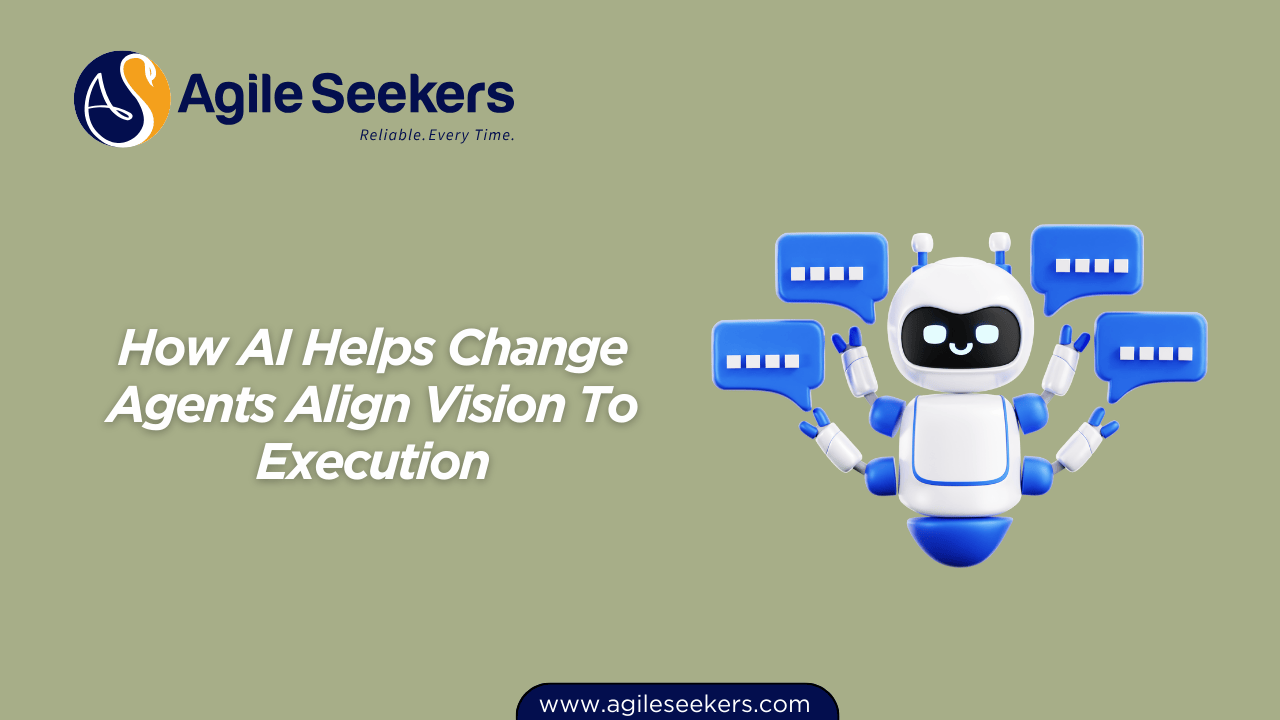How AI Helps Change Agents Align Vision To Execution

Aligning strategy with execution has always been the toughest part of organizational change. Leaders can articulate a vision, but translating it into actionable steps that people can follow is where many transformations stall.
This is where AI becomes an ally for change agents. It doesn’t replace their judgment, but it equips them with insights, clarity, and real-time feedback loops that make alignment less about guesswork and more about precision.
Why Alignment Often Fails
Most transformations start with high energy but lose momentum because:
-
Teams struggle to connect day-to-day work with leadership’s strategic intent.
-
Metrics focus on output (tasks completed) instead of outcomes (value delivered).
-
Communication breaks down across departments, creating silos.
Change agents are expected to bridge this gap. But doing it manually—through endless workshops, slide decks, and check-ins—rarely scales in complex organizations. AI tools, when used wisely, change the equation.
The Role of AI in Strategic Alignment
AI helps change agents move beyond broad goals and into measurable execution. Here’s how:
1. Translating Vision Into Data-Backed Roadmaps
AI-powered planning tools can analyze strategic objectives and map them to dependencies, risks, and team capacity. Instead of vague mission statements, change agents can show leaders how a vision translates into milestones, backlog items, and release timelines.
For example, an AI for Agile Leaders & Change Agents Certification prepares professionals to use these tools to bridge high-level strategy with executable steps.
2. Detecting Misalignment Early
Teams often believe they are working toward the same goal, but subtle misalignment can creep in. AI dashboards detect these drifts by analyzing task data, sprint velocity, or cross-team dependencies.
Instead of waiting for quarterly reviews, change agents can see real-time where execution is drifting from strategy—and address it before it compounds.
3. Enhancing Communication With Intelligent Insights
One of the hardest parts of leading change is explaining the "why" behind the "what." AI-driven visualization tools help change agents show progress, bottlenecks, and value delivery in formats that resonate with executives and frontline employees alike.
For Scrum environments, courses like AI for Scrum Masters Training cover how AI can assist in improving transparency and psychological safety in team communication.
4. Aligning Metrics With Outcomes
Traditional metrics—like the number of tasks closed—don’t capture whether the organization is moving closer to its vision. AI helps define and track outcome-driven metrics: customer satisfaction, business agility, reduced time-to-market.
For Product Owners, this skill is essential. Programs such as the AI for Product Owners Certification Training train professionals to align delivery metrics with value-based outcomes.
5. Supporting Project Managers With Predictive Risk Analysis
Project managers are often responsible for converting strategy into structured delivery. AI can forecast schedule risks, resource bottlenecks, and cost deviations before they impact execution.
The AI for Project Managers Certification Training equips leaders to use AI for smarter, risk-aware project execution.
AI as a Partner, Not a Replacement
AI won’t lead the change for you. It won’t sit in retrospectives or inspire teams. But it becomes a reliable partner in areas where human judgment is prone to blind spots:
-
Pattern detection across massive datasets
-
Predicting future risks from past trends
-
Offering multiple scenario simulations before making commitments
Change agents can combine their human skills—facilitation, empathy, storytelling—with AI’s analytical power to move from vision to reality faster and more effectively.
Practical Examples of AI in Action
Portfolio Planning in Large Enterprises
A global company rolling out a digital transformation initiative often struggles to prioritize which projects align best with strategy. AI-powered portfolio tools can rank initiatives by ROI, resource demand, and strategic value. Leaders trained through Leading SAFe Agilist Certification Training can combine AI insights with Lean Portfolio Management principles to ensure investments support enterprise goals.
Agile Release Trains (ARTs) in SAFe
Product Managers and Product Owners in SAFe environments need to ensure program backlogs reflect both vision and near-term execution priorities. AI helps analyze dependencies and optimize PI Planning. A SAFe POPM Certification ensures professionals can apply AI responsibly within ART contexts.
Scrum Mastery in Evolving Teams
Scrum Masters supporting multiple teams can use AI tools to identify recurring impediments, spot burnout risks, and measure flow efficiency. The SAFe Scrum Master Certification, when combined with AI skills, helps Scrum Masters move from tactical facilitation to strategic alignment.
For advanced facilitators, SAFe Advanced Scrum Master Certification Training extends this knowledge into cross-team coaching supported by AI insights.
Large-Scale Project Execution
For project managers running enterprise-level initiatives, AI project scheduling tools can optimize resources across regions and predict slippages. When paired with a PMP Certification Training, AI adoption accelerates a manager’s ability to ensure execution aligns tightly with the original project charter.
External Perspectives and Resources
Several external studies highlight AI’s role in execution alignment:
-
McKinsey reports that organizations using AI in portfolio prioritization see up to 20% higher ROI.
-
Harvard Business Review highlights how AI enhances transparency and trust in cross-functional execution.
-
Gartner notes AI’s predictive project management tools reduce delivery delays by 30%.
(Links can be added naturally to McKinsey, Harvard Business Review, and Gartner for readers who want further research.)
Key Takeaway
AI doesn’t replace leadership, but it amplifies the effectiveness of change agents. It helps them align vision with execution by providing clarity, detecting misalignment, enhancing communication, and ensuring that outcomes—not just outputs—drive the transformation.
For professionals looking to master these skills, certifications like AI for Agile Leaders & Change Agents, AI for Product Owners, AI for Scrum Masters, and AI for Project Managers offer structured pathways. When combined with established frameworks like Leading SAFe, POPM, and PMP, these programs give change agents the confidence and tools to lead with both vision and precision.
Also read - Top 7 Ways Agile Leaders Can Use AI To Drive Cultural Adoption
Also see - Why Agile Leaders Must Learn Prompt Engineering For Influence




















